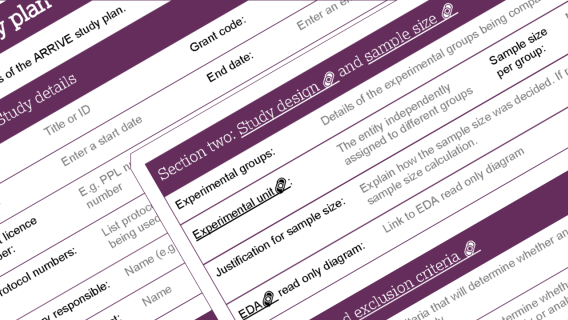The ARRIVE study plan is intended for use by researchers, animal units and ethical review bodies to provide a clear framework for the communication of individual studies. By ensuring all the essential procedural and experimental rigour information is available upfront, ethical review bodies can conduct a thorough harm-benefit analysis and maximise the likelihood of producing high-quality and reliable results that make a meaningful contribution to the scientific knowledgebase.
In 2022, the NC3Rs commissioned an independent review to assess implementation of the 3Rs in ethical review and regulatory processes. The ARRIVE study plan builds on recommendations from Dr Frances Rawle to promote a research, policy and regulatory environment actively supportive of the 3Rs. In particular, Frances highlighted the need to review individual study plans before each study starts, with templates informed by resources such as the ARRIVE guidelines.
Intended to support good experimental practices from the outset, the ARRIVE study plan asks for key information about the experiment upfront; with an added emphasis on minimising bias, selecting appropriate sample sizes and choosing suitable statistical analyses. By documenting the experimental design in a clear and standardised format, the ARRIVE study plan is a tool for researchers to record the procedural and rigour strategies comprehensively and transparently, which can be directly translated into the literature. Quality animal research also requires strong collaboration between researchers and animal technicians. Technicians play a crucial role in implementing strategies to increase experimental rigour, such as randomisation and blinding/masking. Known barriers to using blinding, for example, can be overcome through clear communication, planning and teamwork.
Before embarking on research involving the use of animals it is also critical to form a clear hypothesis, identify possible non-animal alternatives to all or part of the proposed study and assess the relevance of the chosen model to answer the experimental question. We therefore encourage researchers to consult the PREPARE guidelines before considering the use of animals in research. PREPARE provides researchers with an extensive overview to formulating an experiment and the requirements of using animals before carrying out the research.
Creation of the resource
To create the ARRIVE study plan, we conducted a series of scoping, data gathering and interviews with researchers, technicians and Named persons to investigate current study plan infrastructure in the UK and North America. Our findings showed that study plan structures varied considerably between institutions. We found that there was a high concordance and expertise in gathering compliance and welfare refinements of animal experiments, but a significant gap in obtaining and understanding experimental rigour details for a study.
The ARRIVE study plan incorporates new fields to commonplace study plans by gathering experimental design details upfront. The ARRIVE study plans includes succinct guidance to help users fill in the information requested, with further links to the ARRIVE website explaining and elaborating on the information required for transparency in the reporting of a robust animal study.
Experimental design resources from planning to publication
We strongly recommended that the ARRIVE study plan is used in conjunction with the NC3Rs’ Experimental Design Assistant (EDA). Researchers can design their experiments in the online EDA software and provide a URL to a report of their experimental plans when completing the ARRIVE study plan. The EDA offers tailored experimental design feedback to users and the EDA critique tool highlights where rigour strategies have not been considered, including recommendations to improve the design of the study. The Experimental Design Report and ARRIVE study plan can help those on ethical review bodies without experimental design expertise to easily identify missing information and will form the basis of questions to the researcher. By using our resources to plan their in vivo experiments, researchers will record the information needed to later report their findings in high-quality publications. To provide consistent, quality information for researchers using our experimental design and reporting resources, alongside developing the ARRIVE study plan we have released an updated Experimental Design Report to align with the revised ARRIVE guidelines 2.0 and mirror the ARRIVE Essential 10.
We are developing a detailed user guide and reviewer checklist to accompany the ARRIVE study plan to bridge knowledge gaps and maximise the chances that every experiment is set up for success. The user guide will offer clear guidance on how to scrutinise the documentation and the reviewer checklist will promote consistent assessment of ARRIVE study plans between and within institutions. These resources aim to catalyse conversations between researchers and reviewers on the best strategy to improve the conduct and design of a planned animal study.
Visit the ARRIVE study plan resource page for all downloads and guidance on using the documentation.

